Board of Ordnance

The Board of Ordnance was a British government body. Established in the Tudor period, it had its headquarters in the Tower of London. Its primary responsibilities were 'to act as custodian of the lands, depots and forts required for the defence of the realm and its overseas possessions, and as the supplier of munitions and equipment to both the Army and the Navy'.[1] The Board also maintained and directed the Artillery and Engineer corps, which it founded in the eighteenth century. By the nineteenth century, the Board of Ordnance was second in size only to HM Treasury among government departments.[2] The Board lasted until 1855, at which point (tarnished by poor performance in supplying the Army in Crimea) it was disbanded.
Origins of the Board
The introduction of gunpowder to Europe led to innovations in offensive weapons, such as cannon, and defences, such as fortifications. From the 1320s a member of the Royal Household, the 'Keeper of the Privy Wardrobe in the Tower of London', became increasingly responsible for the procurement, storage and distribution of weapons. His office and main arsenal were located in the White Tower.[3] This 'Privy Wardrobe in the Tower' grew, both in size and significance, after the start of the Hundred Years' War.
In the following century, a distinct Office of Ordnance began to establish itself at the Tower, staffed in the 1460s by a Master, a Clerk and a Yeoman. (The influence of the Privy Wardrobe and its staff had by this time receded; no new Keepers were appointed after 1476).[4] In the 1540s, under Henry VIII, the Ordnance Office was expanded, new officers were appointed and their principal duties clarified.
In 1671, the Office of Armoury (a parallel body, also based at the Tower) was abolished and the Ordnance Office took over its work; (it had originally been responsible for provision of armour and edged weapons, but latterly there had been substantial overlap between it and the Ordnance).[5] It was around this time that the Office began to take on oversight of the nations forts and fortifications. In 1683 the Office, by now increasingly known as the Board of Ordnance, was given a new constitution ('Instructions') by Lord Dartmouth as Master-General. These detailed Instructions continued, with relatively little change, to provide the working framework for the Board and its officers through till the early 19th century.[4]
Principal officers
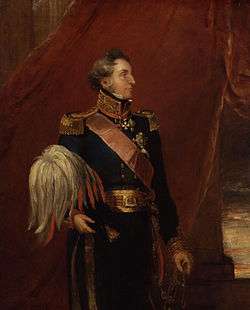
From the mid-16th century onwards, the Board of Ordnance had six principal officers. Two overseers:
- Master (later Master-General) of the Ordnance (head of the board)
- Lieutenant (later Lieutenant-General) of the Ordnance (deputy)
And four heads of department:
- Surveyor-General of the Ordnance (in charge of quality)
- Clerk of the Ordnance (in charge of purchasing)
- Storekeeper of the Ordnance (in charge of storage)
- Clerk of the Deliveries of the Ordnance (in charge of issuing)
The offices of Master and of Clerk of the Ordnance may be said to date from 1414, when Letters Patent were issued on behalf of Henry V of England to 'Nicholas Merbury, Master of our Works, Engines, Cannons and other kinds of Ordnance for War, and to John Louth, Clerk of the same Works'[2] (though it appears that these were appointments for service in the field of war rather than to a permanent position).[4] Merbury was present at the Siege of Harfleur and at the Battle of Agincourt.[7] By 1450 Master of Ordnance was a permanent appointment, firmly based at the Tower of London.
Until 1544 the Master had generally managed the day-to-day activities of the Ordnance Office. In that year, however, King Henry VIII appointed his brother-in-law Thomas Seymour as Master of the Ordnance, displacing the incumbent Sir Christopher Morris, who continued his previous work but with a new title: Lieutenant of the Ordnance. Thereafter the Lieutenant (or Lieutenant-General) had day-to-day oversight of the Board's activities, while Master (or Master-General) had more the role of a statesman and supervisor (albeit still with specific responsibilities to the Board and its work).[4]
From the seventeenth century through till 1828 the Master-General routinely had a seat in Cabinet, and thus served as de facto principal military adviser to the government. Some of the most illustrious soldiers of their generation served as Master-General: Marlborough, Cadogan, Cornwallis, Hastings, Wellington, Hardinge.[2]
Other personnel
From its earliest years, the Ordnance Office was staffed by a large number of Clerks to manage its substantial administrative functions. A number of other officials reported to the board, including furbishers, proofmasters, keepers and fireworkers.
Two appointments stand out, as they (like the six Board members) were appointed by Letters Patent under the Great Seal of the Realm: namely the Master Gunner of England and the Chief Engineer.[4] These were the senior technicians on the staff. The appointment of Master Gunner was first made as early as 1485, though it ceased after the establishment of the Regiment of Artillery in the 18th century; that of Chief Engineer was instituted in 1660.
The Treasurer of the Ordnance was another important officer of the department, although he did not sit on the board.[4] This office was instituted in 1670 (its duties having previously been discharged by the Lieutenant-General); the post was consolidated with several others in 1836 to form that of Paymaster-General.
The Board also had a network of officers in place in key forts, ordnance yards and other installations throughout the Realm (including overseas). The senior Ordnance officer in these locations was usually termed the Storekeeper, and he was responsible directly to the Board. Prior to the Union of the Crowns there was a Master of the Ordnance in the North (with oversight of Berwick, Newcastle and the nearby coastal forts) who had greater autonomy, though he was reliant on the London office for most supplies. Moreover, a Master of the Ordnance in Dublin oversaw a largely independent Irish Board of Ordnance until 1801.[8]
Coat of Arms
The Arms of the Board of Ordnance first appeared in the seventeenth century, and were given royal approval in 1806, confirmed by a grant from the College of Arms in 1823. The blazon is as follows:[9]
- Arms: Azure - 3 Field Pieces in pale, or; on a chief, argent, 3 cannonballs, proper.
- Crest: Out of a mural crown, argent, a dexter cubit arm, the hand grasping a thunderbolt, winged and inflamed, proper.
- Supporters: On either side a Cyclops, in the exterior hand of the dexter a Hammer, and in that of the sinister a pair of Forceps, resting on the shoulder of each respectively, all proper.
- Motto: sua tela tonanti. ['To the thunderer his weapons'; also more loosely translated as 'To the warrior his arms'].
Broad Arrow
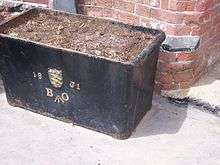
The broad arrow was the Board's mark, used as such from the 17th century. Stamped on guns, papers, buildings and all kinds of equipment, it originally signified royal ownership. A proclamation of 1699 clarified its use on stores of war belonging to the Board of Ordnance; just over a hundred years later, in 1806, the Board directed its Storekeepers and others to mark "all descriptions of Ordnance Stores ... with the broad arrow as soon as they shall have been received as fit for His Majesty's Service".[10]
Activities
Storage and supply: the Ordnance Yards
Headquarters: the Tower of London
_(8145459210).jpg)
In the medieval period, storage and supply of weapons and armaments was the responsibility of the King's Wardrobe. Royal palaces (including the Tower of London) were therefore used for storage of armour, weapons and (in time) gunpowder. When the Office of Ordnance came into being, the Tower of London was already established as the main repository, and it remained the administrative centre of the new Board. Gunpowder was stored in the White Tower (and continued to be kept there until the mid-nineteenth century). Small arms, ammunition, armour and other equipment were stored elsewhere within the Tower precinct, a succession of Storehouses and Armouries having been built for such purposes since the fourteenth century. From the mid-16th century bulkier items began to be stored in warehouses in the nearby Minories.[8]
Within the Tower, the New Armouries of 1664 served the Board as a small arms store (it can still be seen today in the Inner Ward). The vast Grand Storehouse of 1692 served not just as a store, but also as a museum of ordnance, precursor to today's Royal Armouries. (It was destroyed (along with its contents, some 60,000 objects) in a fire in 1841).[11]
Distribution points: the Royal Dockyards
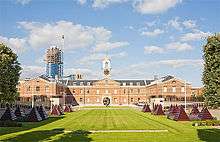
The Board established storage and maintenance areas close to the Royal Dockyards to enable easy transfer of guns, ammunition, powder, etc. on board ships (for use by the Navy at sea or for delivery to the Army in areas of conflict). They also provided ordnance supplies for the defensive fortifications of the Dockyard itself, and secure storage space for ships in port (Royal Naval ships returning from duties at sea were obliged to unload their stores of powder and ammunition; if a ship was to spend time 'in ordinary' (i.e. out of commission) it had its guns removed as well).
In the 16th century the Ordnance Office had established 'annexes' in Chatham, Deptford and Woolwich; others were to follow in the vicinity of the other major Dockyards. These facilities, generally known as Gun Wharves, developed into purpose-built Ordnance Yards in the course of the eighteenth century. Built alongside deep-water quays, they usually comprised an assortment of buildings for storage, administration blocks, workshops (for woodwork, paintwork and metalwork) together with accommodation for officers, usually built around a central Grand Storehouse (primarily used for gun carriages). Exterior courtyards were laid out for the storage of cannonballs.[12]
The principal home Yards included:
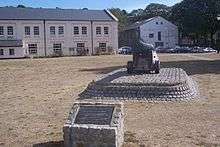
- HM Gun Wharf, Chatham
- Morice Yard, Devonport (replaced an earlier gun wharf just east of Mount Wise)
- Gunwharf, Portsmouth
- Gun Wharf, Sheerness
- Gun Wharf, Woolwich. (The proofing and storage facility at Woolwich Gun Wharf expanded to the east in the late seventeenth century, eventually becoming the Royal Arsenal: a key Ordnance Board facility.)
Smaller Yards were built in parts of Britain to serve particular strategic purposes at particular times (such as the Yard in Great Yarmouth,[13] built to service the fleet stationed in Yarmouth Roads during the Napoleonic Wars).[14]
During the Napoleonic Wars, concerns were expressed about the vulnerability of the nation's ordnance stores to attack from the sea. One response was the establishment of a Royal Ordnance Depot at Weedon Bec, well away from the coast in Northamptonshire: a sizeable complex of storehouses and gunpowder magazines constructed along a waterway, it was connected to the Grand Union Canal to facilitate access and distribution.
Ordnance Yards were also constructed in colonial ports overseas; like their counterparts in Britain, these were usually built in the vicinity of naval dockyards. Bermuda's, begun in the 1830s, remains largely intact behind the dockyard fortifications; its magazines and storehouses are arranged around a small pool, where boats would arrive by way of a tunnel through the ramparts to be loaded with ammunition.[15]
Gunpowder storage
For storage of Gunpowder, a nearby fortified building was often used initially: the Square Tower at Portsmouth, the Citadel at Plymouth, Upnor Castle at Chatham; later, the Ordnance Board created purpose-built Gunpowder Magazines, often apart from the Yards, and at a safe distance from inhabited areas.[14] There were also smaller magazines, supervised by Ordnance Board staff, at several fortified locations around the British Isles (from Star Castle on the Scilly Isles, to Fort George near Inverness).
The Tower of London remained the main, central repository until 1694, when a new gunpowder depot was established on the banks of the Thames at Greenwich Peninsula. The location was chosen both for reasons of safety (it was largely uninhabited marshland) and for convenience (because gunpowder barrels were invariably delivered by boat). The powder arrived at Greenwich from the manufacturers. Once there it was not only stored, prior to being despatched to wherever it might be needed, but a sample from each batch was proof tested. This took place in one of a pair of smaller buildings alongside and linked to the main magazine (which was a windowless quadrangle).[16]
Very soon, however, the Board was coming under pressure from local residents to remove the gunpowder store from Greenwich. Eventually, in 1763, a new set of magazines were built, along with a new proof-house, further downriver at Purfleet. Named the Royal Gunpowder Magazine, it was likewise used as a central store, to receive and approve gunpowder from the manufacturers prior to distribution around the country. (Soon afterwards the Greenwich magazine closed, and it was later demolished.)
At around the same time, significant improvements were made to the gunpowder depots at the Dockyards (where the Board was still often using old buildings in built-up areas). New purpose-built storage facilities were constructed close to the principal Dockyards at Portsmouth (Priddy's Hard) and Devonport (Keyham Point), and at Chatham the Upnor facility was (eventually) expanded. These centres continued to grow, as the processes for refining and preserving gunpowder became more complicated and as new explosives began to be used, requiring their own storage and maintenance areas.
In 1850, Devonport's magazine depot was moved from Keyham to a new complex at Bull Point (where it was integrated with a nearby proofing and purifying facility) - this proved to be the last major construction project of the Board of Ordnance before its disestablishment.
Manufacture: the Ordnance Factories
Prior to the eighteenth century the Board had generally relied on private contracts for the provision of armaments: small arms often came from the Birmingham Gun Quarter, gunpowder from Faversham (also, later, from Waltham Abbey). Cannons and shot were procured from iron foundries (initially those in the Kent and Sussex Weald, later from further afield, e.g. from the Carron Works in Falkirk). More expensive 'brass' (bronze) ordnance was produced on a smaller scale, by specialist foundries mostly in the London area (in Houndsditch, Vauxhall, Southwark, at The Foundery in Moorfields and elsewhere). In time, the Board made moves to set up or purchase its own facilities.[17]
Artillery manufacture
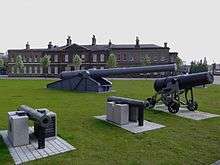
The Board's primary manufacturing site, and a key location for several of its activities, was the Royal Arsenal in Woolwich. Guns had been stored and proved there from the mid-seventeenth century. It later expanded into a large-scale production facility, specializing in:
- manufacture of shells, projectiles and propellants (Royal Laboratory, established at Woolwich in 1695, previously based at Greenwich)
- manufacture of cannons, mortars and other artillery pieces (Royal Brass Foundry (aka Gun Factory), founded 1717)
- manufacture of gun carriages and other ancillary items (1750s onwards; given identity as the Royal Carriage Works in 1803).
Gunpowder manufacture
Gunpowder manufacture was mostly kept separate of other operations (though some took place at Woolwich in the early years, inherited from the Wardrobe's earlier activities at Greenwich Palace). Beginning in the eighteenth century, the Board began to purchase mills that had been established under private ownership:
- Faversham became the Royal Powder Mill in 1759
- Waltham Abbey became the Royal Gunpowder Factory in 1787
- In Ireland, the Ballincollig Royal Gunpowder Mills were purchashed in 1805, having been set up as a private enterprise ten years earlier.
Ordnance Board activity at Ballincollig ceased in 1815; both it and Faversham were returned to private ownership in the 1820s-30s, but Waltham Abbey remained in Government hands until 1991.
Small Arms manufacture
Small arms manufacture was begun by the Board on Tower Wharf in 1804, before being moved to Lewisham (Royal Manufactory of Small Arms, 1807) and then transferring ten years later to Enfield (Royal Small Arms Factory, opened 1816). RSAF Enfield continued manufacturing until its closure in 1988. There is some indication that William Galloway, a gunsmith, produced long guns for the Tower's small arms office in the 1780s.
Forts and fortifications
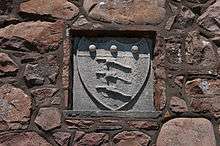
From the mid-17th century the Board of Ordnance began to be involved in the design, building and upkeep of forts, fortifications and various garrison buildings. Around the year 1635, a Francis Coningsby was appointed 'Commissary-General of all His Majesty's Castles in England and Wales'. From 1660 the title was Engineer-in-Chief. The Chief Engineer had responsibility for drawing up designs, supervising site surveys and building works, and visiting established defence sites to evaluate their state of repair, readiness etc. An illustrious holder of this post was Sir Bernard de Gomme. In 1802 the post of Inspector General of Fortifications was established, and this official took over supervision of these works.[18]
The Board also had responsibility for the building and upkeep of barracks and associated structures (except during a 30-year period, 1792-1822, when responsibility was transferred to the War Office).[19]
Personnel: the Ordnance Corps
A number of different Corps were established by the Board of Ordnance to carry out its work both in its home establishments and on the field of battle; they had (and to some extent retain) a very distinctive identity and ethos. Principal among these were the Royal Artillery and the Royal Engineers. These Corps were under the authority of the Board of Ordnance, rather than the War Office (until the Board's demise in 1855). They were not part of the Army, and their officers' commissions were issued by the Master-General of the Ordnance rather than by the Commander-in-Chief of the Forces. The Ordnance Medical Department was established to provide surgeons for these corps.
Royal Artillery
In 1716 the Duke of Marlborough, in his capacity as Master General of the Ordnance, oversaw the formation (by Royal Warrant) of two permanent companies of field artillery, based (together with their guns) at the Warren (Royal Arsenal), Woolwich. Prior to this, artillery pieces had been conveyed to the front line in any conflict by ad hoc artillery trains (their personnel convened for a limited duration by Royal Warrant). The men of the new artillery companies (which became the Royal Regiment of Artillery from 1722) now provided troops for this purpose; before long, they were also providing guns and heavy artillery for forts and garrisons around the country and indeed across the Empire. In addition, the Artillerymen did on-site work at the Arsenal and at other Ordnance Board facilities, from preparing fuses and proving weapons to providing a guard. 1793 saw the formation of the Royal Horse Artillery (who were likewise under the authority of the Board of Ordnance) to provide artillery support to the Cavalry.[20]
Royal Engineers
From the start, the Board (and its predecessor the Office) of Ordnance had had a department of military engineers and surveyors to build and improve harbours, forts and other fortifications. In 1716 a Corps of Engineers was founded by the Board of Ordnance, again at their Woolwich base. Initially an officer-only corps, the Engineers (called Royal Engineers from 1787) were engaged in the design, construction and ongoing maintenance of defences, fortifications and other military installations. They were also engaged for large-scale civilian projects from time to time. A civilian corps of 'artificers' provided the non-commissioned workforce of carpenters, stonemasons, bricklayers and other labourers; this corps was militarized in 1787, and named the Royal Military Artificers (they were then renamed the Royal Sappers and Miners 25 years later). The year after the demise of the Ordnance Board, the Sappers and Miners were fully amalgamated into the Royal Engineers, and at the same time the Corps moved from Woolwich to its present headquarters in Chatham.
Other corps
Supply, storage and provision of small arms, ammunition and other armaments to front-line troops was also within the remit of the Board of Ordnance. A Field Train department was established in 1792 to oversee this work; after the Board's demise, its responsibilities were eventually consolidated into what became the Royal Army Ordnance Corps. It remained headquartered at the Tower of London, even after the Board's departure, preserving the (by then) centuries-old link between the Tower and ordnance storage & supply - a link which was only broken when the Corps' successor (the Royal Logistic Corps) left the Tower for good in 1993.
The Royal Corps of Military Surveyors and Draftsmen was a military corps under the [Board of Ordnance, formally established in 1800 and disbanded in 1817.[21] It was one of the predecessors of the Ordnance Survey.[22]
Education and training: The Royal Military Academy
.jpg)
The Board of Ordnance placed a high value on providing its future officers with a scientific and military education. In the eighteenth century there was no requirement for would-be Army officers to receive any formal military education; but the Board, in contrast, moved fast (after the establishment of its artillery and engineer corps) to provide for the education of its officers. In 1720 there were moves to set up an 'academy' within the Warren at Woolwich where the corps were based; and on 30 April 1741 the Academy was formally established there by Royal Warrant. The fact that the Warren itself was a place of scientific experiment and innovation no doubt helped form the style of education that emerged. Initially, it was a gathering of 'gentlemen cadets', brought together to learn 'gunnery, fortification, mathematics and a little French'. By 1764, the institution had been renamed the Royal Military Academy, and in the words of the Survey of London, 'it became a uniquely enlightened establishment in which training comprehended writing, arithmetic, algebra, Latin, French, mathematics, fortification, together with the attack and defence of fortified places, gunnery, mining and laboratory-works [...] along with the gentlemanly skills of dancing and fencing’.[23] In time, the Academy outgrew its original home in the Arsenal, and in 1806 it moved into new headquarters on Woolwich Common. In 1946 it amalgamated with the Royal Military College to form the Royal Military Academy Sandhurst.
Other activities
Mapmaking: the Ordnance Survey
As part of its duty of maintaining and building harbours and fortifications, a department of the Board was in place to undertake surveys and to produce maps. This department developed into the Ordnance Survey, which remains in place today as Britain's national mapping agency. The principal offices and drawing room of the Survey were in the Tower of London; this not only accommodated surveyors and draughtsmen, but also functioned as a place where cadets (some as young as eleven or twelve) were trained in mathematics and draughtsmanship by leading practitioners. In 1841 a fire prompted the Survey to move to new premises in Southampton; following the demise of the Board, it became part of the War Department.[24]
The Royal Observatory, Greenwich
In 1675, the post of Astronomer Royal was established by Royal Warrant. The Board of Ordnance was warranted to pay the Astronomer's salary, and also to construct a Royal Observatory in Greenwich. This has been called the first instance of government funding for science; money was to be provided from 'the sale of old or decayed gunpowder'.[25] The Board of Ordnance continued to provide annual funding for the Observatory until 1818, when the Admiralty took over this responsibility. Despite providing funds, the Board was not in any way involved in the operational side of the Observatory, which was managed independently by the Astronomer Royal under the governance of a Board of Visitors.
Her Majesty's Magnetic and Meteorological Observatory, Toronto, Upper Canada
Built at old barracks at Old Fort York in 1839-1840 by Royal Artillery and relocated later in 1840 to Queen's Park (Toronto) at the site of the Toronto Magnetic and Meteorological Observatory.
Demise and Aftermath
In 1830, the principal officers were reduced to four by the abolition of the posts of Lieutenant-General and Clerk of the Deliveries. Arguably, this exacerbated the problems that led to the Board's demise.[26]
Issues of performance in the Crimean War, especially disastrous lack of due provision for operations during the Russian winter of 1854[27]:p 53 brought about the Board's demise in 1855: [See also the reference to Lord Raglan below.]
As a result of enquiries made into the breakdown of transport and hospital arrangements during the first winter of the war, the Board of Ordnance, which had been in existence for four hundred years, was abolished. With the Board's closure, the Artillery together with the Royal Engineers came directly under the Commander-in-Chief and the War Office like the rest of the Army.[27]:p 55
The former board was incorporated into the War Office by an 1855 Act of Parliament (18 & 19 Vict. c. 117) as the Department of the Master-General of the Ordnance, which took over most of its activities. Its storage, research and manufacturing sites were for the most part allotted either to the Admiralty or to the War Office (several remained active through to the latter half of the twentieth century, as Royal Ordnance Factories, Royal Naval Armaments Depots, etc.).
Almost fifty years later, following unease after the Second Boer War that the British Army had been ill-equipped, a new office called the Ordnance Board was created. It consists of a board of munitions experts, whose purpose was to advise the Army Council on the safety and approval of weapons. The Ordnance Board, and its name, survived within the Ministry of Defence until the mid-1990s when it was renamed the Defence Ordnance Safety Group. Long before then, the Ordnance Board had extended its scope to encompass more than just the safety and approval of the Army’s ordnance.
The old Board's coat of arms is remembered in the capbadge of the Royal Logistic Corps, which has the shield at its centre (it was previously used, along with the Board's motto, by the Royal Army Ordnance Corps). The shield is also used by the modern-day Master-General of the Ordnance; and the crest appears on the ensign of the Royal Engineers.
Notable staff
- One of its 18th century map-makers was noted water-colour artist Paul Sandby.
- Lord Raglan, the British commander-in-chief during the Crimean War, was also the last Master-General of the Board of Ordnance.[28] It is very likely that his incompetence in the field of battle was more to blame than the Board of Ordnance for the 1854-55 supply failures. Ironically, he himself died of dysentery in the Crimea on 29 June 1855 at a time when his forces were afflicted with cholera and reeling from a disastrous series of military failures.[29]:p 302
(In 1855) . . . a loud outcry against Lord Raglan had begun in the press. He was charged with neglecting to see to the actual state of his troops, and to the necessary measures for their relief. Their condition was becoming more and more pitiable; their numbers dwindling rapidly from death and disease. The road between Balaclava and the camp had become a muddy quagmire, the few remaining horses of our cavalry were rapidly disappearing, every day the difficulty of getting up food and other necessaries from Balaclava was becoming more serious, and still no provision was being made for supplying an effective means of transport.[29]:p 181
See also
- List of Masters-General from 1415
- The Royal Artillery and the Royal Engineers, both of which were Board of Ordnance initiatives
- The Royal Military Academy, Woolwich, set up by the Board to train and educate its officers
- Royal Ordnance Factories
- Ordnance Survey
- Ordnance yards and other facilities, including Gunpowder magazines
- Tower of London, headquarters of the Board
- Woolwich Royal Arsenal (a key Ordnance facility)
- Broad arrow
- Anthony Roll
References
- ↑ History of the Ordnance Survey, quoting older sources
- 1 2 3 Skentlebery, Norman (1975). Arrows to atom bombs: a history of the Ordnance Board. London: Ordnance Board.
- ↑ Royal Engineers Museum - The Corps, Ordnance and its Train (1370-1713) - Part 2
- 1 2 3 4 5 6 Tomlinson, H. C. (1979). Guns and Government: the Ordnance Office under the later Stuarts. London: Royal Historical Society.
- ↑ Royal Armouries detailed historical overview
- ↑ Confirmed 'by command of the Prince Regent', General Orders, July 1811.
- ↑ Part 01 - Arms of the Board of Ordnance
- 1 2 Stewart, Richard W. (1996). The English Ordnance Office: a case-study in bureaucracy. Woodbridge, Suffolk: Royal Historical Society (Boydell Press).
- ↑ Reproduced copy of the grant of arms
- ↑ "History of the Broad Arrow". Royal Australian Army Ordnance Corps. Retrieved 6 August 2016.
- ↑ Tower of London website
- ↑ English Heritage survey of Naval Dockyards
- ↑ Listed building descriptions
- 1 2 English Heritage: Thematic History of Ordnance Yards and Magazine Depots
- ↑ Coad, Jonathan (2013). Support for the Fleet: Architecture and engineering of the Royal Navy's bases, 1700-1914. Swindon: English Heritage.
- ↑ Mills, Mary. "Greenwich Marsh: the 300 years before the Dome". Greenwich Peninsula History. Retrieved 31 August 2015.
- ↑ National Archives: historical summary
- ↑ Saunders, Andrew (1989). Fortress Britain. Liphook, Hants.: Beaufort.
- ↑ Douet, James (1997). British Barracks 1660-1914.
- ↑ National Army Museum regimental history page
- ↑ Records of the Ordnance Survey of Great Britain 2016-01-21.
- ↑ Royal Armouries: Ordnance Survey 2106-01-21.
- ↑ Saint & Guillery, The Survey of London vol. 48: Woolwich, Yale, 2012.
- ↑ Seymour (ed.) (1980). A History of the Ordnance Survey. Folkestone, England: Wm Dawson &Sons.
- ↑ The Royal Observatory: history
- ↑ Royal Armouries: Board of Ordnance
- 1 2 Graham C A L DSO psc, Brig Gen The Story of the Royal Regiment of Artillery RA Institution, Woolwich 1939
- ↑ Abolition of the Board of Ordnance,1855 On website of Royal Engineers Museum
- 1 2 Martin T The Life of His Royal Highness the Prince Consort Smith Elder & Co, London (1877) Vol III p 180 (Online version transcribed from copy in the University of California)